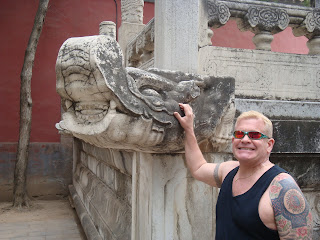-----
The Ming Dynasty Tombs (Chinese: 明朝十三陵; pinyin: Míng cháo shí sān líng; lit. Thirteen Tombs of the Ming Dynasty) are located some 50 kilometers due north of urban Beijing at a specially selected site. The site was chosen by the third Ming Dynasty emperor Yongle (1402–1424), who moved the capital of China from Nanjing to the present location of Beijing. He is credited with envisioning the layout of the ancient city of Beijing as well as a number of landmarks and monuments located therein. After the construction of the Imperial Palace (the Forbidden City) in 1420, the Yongle Emperor selected his burial site and created his own mausoleum. The Ming tombs of the 13 emperors of the Ming Dynasty were located on the southern slope of Tianshou Mountain (originally Mount Huangtu).
The site of the Ming Dynasty Imperial Tombs was carefully chosen according to Feng Shui (geomancy) principles. According to these, bad spirits and evil winds descending from the North must be deflected; therefore, an arc-shaped area at the foot of the Jundu Mountains north of Beijing was selected. This 40 square kilometer area — enclosed by the mountains in a pristine, quiet valley full of dark earth, tranquil water and other necessities as per Feng Shui — would become the necropolis of the Ming Dynasty.
Dingling (Chinese: 定陵; pinyin: Dìng Lìng; literally "Tomb of Stability"), one of the tombs at the Ming Dynasty Tombs site, is the tomb of the Wanli Emperor. It is the only one of the Ming Dynasty Tombs to have been excavated. It also remains the only imperial tomb to have been excavated since the founding of the People's Republic of China.
-----

In the plaza at the entrance of the site, looking out toward the hills.

Entrance gate at Dingling

Walkway descending into a tunnel
Trees grow on top of the tomb itself

After descending down several flights of stairs you find yourself in the tomb which is littered with money. Evidently, there was a hole underneath this pile of cash and it is considered lucky if you can toss your money in there.

Original archway

The emperor's throne. If I were the emperor I would have had them at least put a few pillows on that baby.

The large red boxes are the imperial coffins while the small ones are said to hold their belongings

The Chinese apparently like to pay taxes to all leaders, dead or alive.

M.C. Escher doorway

On the way out of the tomb I happened upon this beautiful dragon light fixture decoration.

This place was beautiful, covered with trees as far as you could see. Unfortunately, the smog was kind of ruining the view of the hills.

I enjoy interesting uses of hyphenation... or the lack thereof.

There were a couple of galleries of artifacts around the site. This is a lavish headdress that would have been worn by one of the royal family.

Tony poses with a stone carving that he likes.

This big ass turtle stood a foot taller than me and had a huge tablet with Chinese writing on it protruding from its shell several feet into the air.
More from Wikipedia:
----- A seven kilometer road named the "Spirit Way" (Shen dao) leads into the complex, lined with statues of guardian animals and officials, with a front gate consisting of a three-arches, painted red, and called the "Great Red Gate". The Spirit Way, or Sacred Way, starts with a huge stone memorial archway lying at the front of the area. Constructed in 1540, during the Ming Dynasty, this archway is one of the biggest stone archways in China today.
-----
When we got here, we sat down for a nice bread and cheese picnic before proceeding down the pathway between the impressive statues.
Lovely soft willows lined the way
Here are a few shots of my favorite statues:
Througout the site there were these great little tables with elephants as chairs.
The dragon and phoenix gate at the end of Spirit Way.
Sorry for the cop-out entry folks. Sleep beckons.












No comments:
Post a Comment
If you comment using the "Anonymous" option, please leave your name so I know who you are!